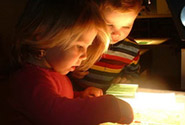Unequal Weights Balance

Physics can surprise us when a condition exists that we do not consider. In this video a child balances log cross-sections on a board that rests on a large curved block. Because the pivot is not a point, but rather a curve, it is possible for the boy to balance unequal weights. The physics has not changed. The round block underneath, in essence, changes the location of the fulcrum. The length of the board to the right of the fulcrum becomes longer (by tilting upward) if he places more weight on the left side of the board. The curved board automatically adjusts the position of the fulcrum to create balance between the amount of weight per side and the amount of distance to the fulcrum.
We can use these anomalous set-ups to study, in a casual and playful way, the nature of the child’s surprise. A young child might simply think, “These blocks are different” and continue to play without much surprise at all. But when children begin to develop the idea that nature has some fairly reliable rules, this set-up can cause discomfort or curiosity.
Do you think the boy in this video finds it curious that most of his weight arrangements find their own equilibrium, even when he has only one weight on one side and nothing on the other? He talks about a weight that “holds it up” and for some reason adds a third weight directly in the middle. The teacher puts his strategy into words (Timecode 00:39). Is he thinking about the weight in the middle pressing down the way one might do with a finger to keep something steady? Notice when the boy puts a rather large weight on the right, and the board still finds a point of equilibrium (Timecode 00:43). How would you judge his reaction? Is he surprised in a strong way or a mild way? Why do you think the boy deliberately makes the blocks “all fall down” (Timecode 02:03)? What information might this give him, or what goal might this satisfy?
Watch the entire clip and think about the boy’s thinking. Is he testing out ideas? What are his ideas? Of course, the big question occurs to us: Do you think this set-up can teach the boy something new about fulcrums, or is it more likely to confuse the boy about how a balance beam works (such as knowing how a light-weight girl can see-saw with a heavier boy by sliding back on her side of the see saw)? Would you give the child a different set-up the next day? What new set up might make sense?
